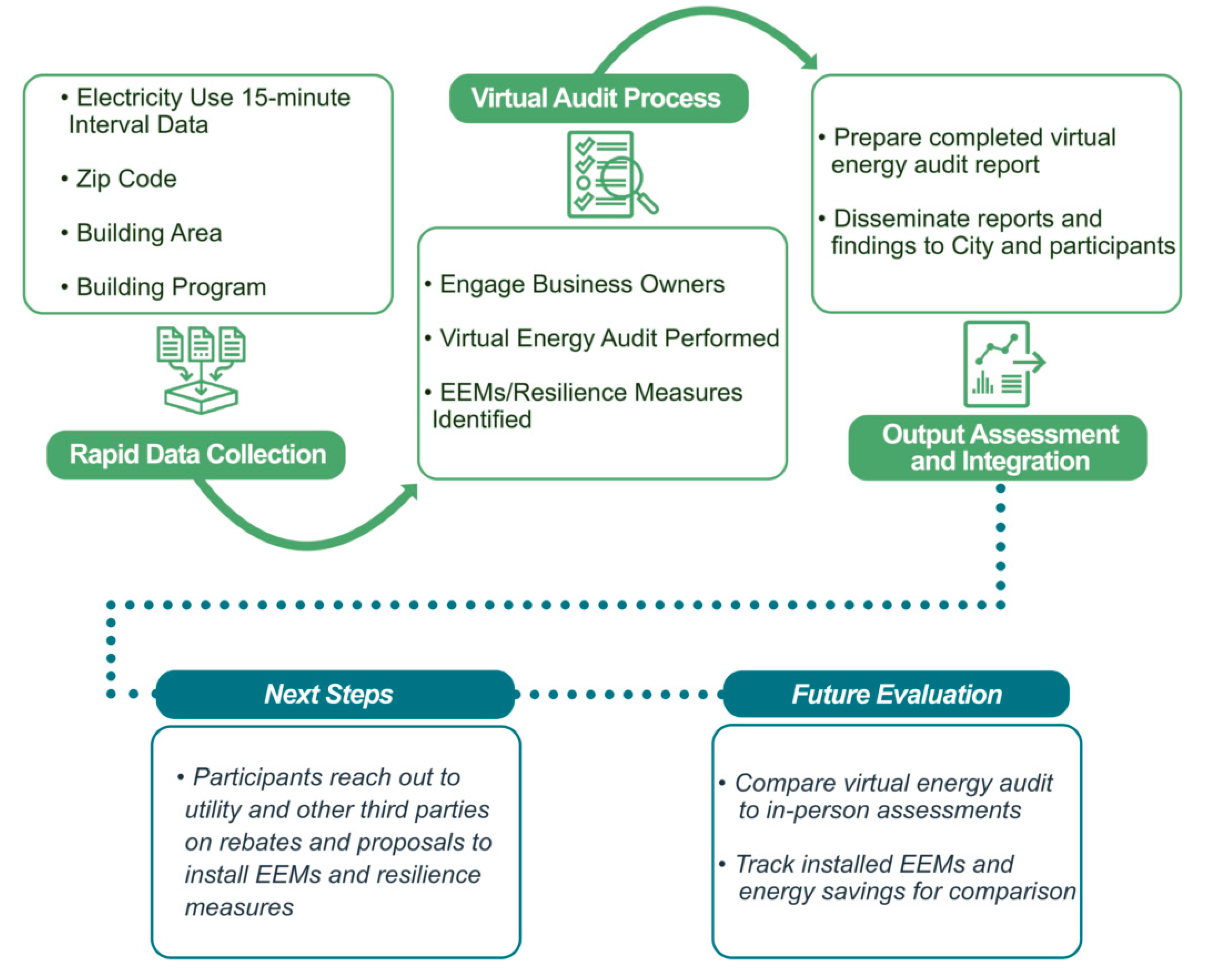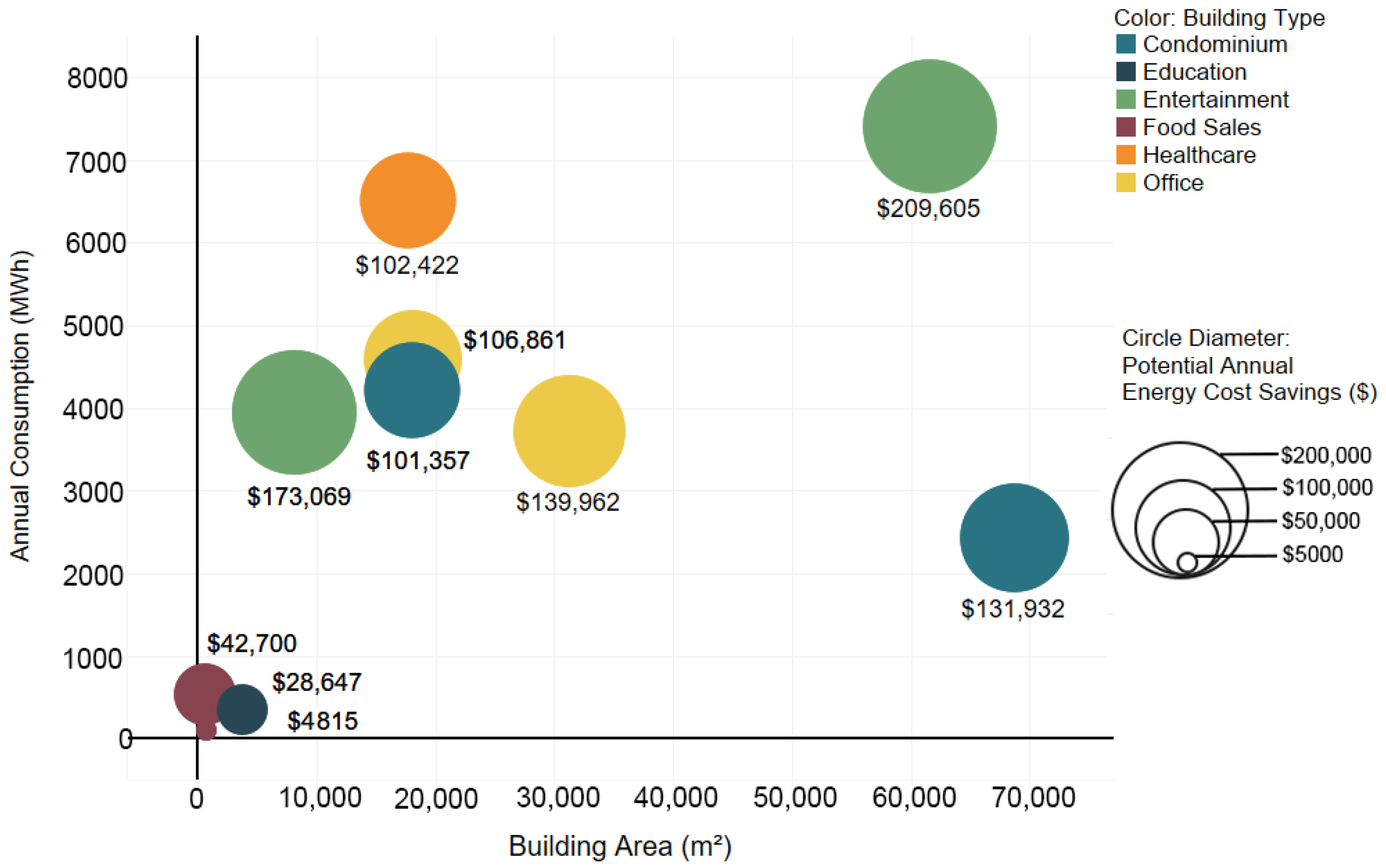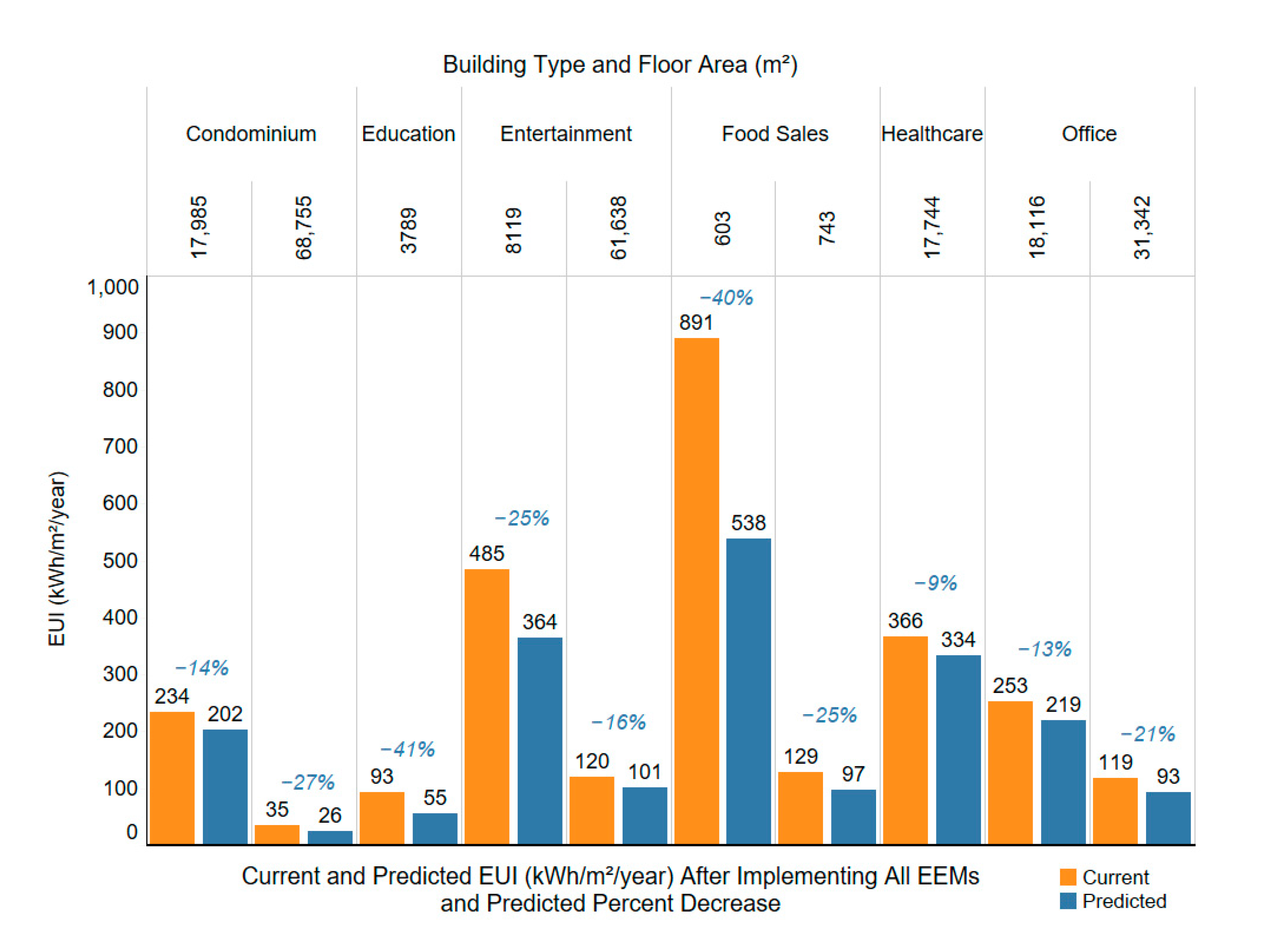Analysis of Methodology for Scaling up Building Retrofits: Is There a Role for Virtual Energy Audits?—A First Step in Hawai’i, USA
Abstract
:1. Introduction
The Initiative as a COVID-19 Response
2. Methods
2.1. Buildings and Data Acquisition
2.2. Data Analysis Software
2.3. Virtual Energy Audit Reporting
- Energy use intensity benchmarking by building category and climate type;
- Energy consumption pattern “snapshot”: a graph showing annual average hourly energy consumption by day of the week during winter and summer seasons. Box and whiskers indicate the variability of energy use;
- Baseload cooling savings;
- HVAC reschedule savings;
- Setpoint setback savings;
- HVAC size/efficiency savings: replacing equipment;
- Window replacement savings;
- Plug load and interior lighting savings: replacing equipment;
- Refrigeration savings: replacing commercial equipment;
- Exterior lighting savings: adding daylight sensors or a schedule;
- Building shell savings: air-sealing, added insulation, roof replacement;
- Additional cost for increased ventilation (without EEMs implemented);
- Weighted total savings estimate.
2.4. Increased Ventilation in Response to COVID-19
2.5. Appendices to the Virtual Energy Audit Report
- Appendix A [16] is divided by energy end-use and describes:
- ◦
- Checklists of very specific EEMs recommended by ASHRAE to consider implementing;
- ◦
- Hawai’i Energy’s financial incentives for implementing each EEM;
- ◦
- Hawai’i Energy’s participating contractors; and
- ◦
- Temporary pandemic-related ventilation and indoor air quality measures to consider implementing.
- ◦
- A list of references.
- Appendix B lists Hawai’i Energy’s recommendations for Business Re-entry, HVAC Operations & Energy Impact [17].
- Appendix C consists of the ASHRAE Epidemic Task Force Commercial Guidelines [18].
3. Results
3.1. Energy Analysis and Predicted Savings
3.2. Increased Energy Use with Increased Ventilation in Response to COVID-19
4. Discussion
- The Initiative’s virtual energy audits identified EEMs for end uses relevant to the commercial sector in the subtropical environment, such as air conditioning, ventilation, plug loads, and lighting. As mentioned previously, commercial electricity customers consume 32.72% of the total electricity produced in the United States;
- A virtual audit feature that estimates energy costs associated with increasing ventilation to improve indoor air quality emerged during the COVID-19 pandemic;
- Although increasing ventilation during the pandemic would temporarily increase energy use, implementing other EEMs would save energy. The Initiative’s virtual energy audits provide businesses affected by the pandemic with a quick estimate of potential energy increases and savings.
- Identify specific opportunities to be investigated via on-site assessment and potential actions that may be considered;
- Identify potential financial incentives for EEMs to create further cost savings and contractors familiar with utilizing those incentives;
- Consider the potential energy cost savings, including potential rebates, when evaluating solicitations to implement the recommended measures and savings opportunities.
5. Conclusions
- The low cost of a virtual energy audit versus an in-person audit makes it a more feasible first step when considering large-scale deployment;
- The building owner or facility operator is not required to initiate or spend time on the virtual energy audit process. Electricity use may be provided directly from the utility;
- The virtual energy audits rapidly estimate potential annual energy cost savings, which may motivate the building owner or operator to pursue the suggested next steps with an on-site assessment. There are additional time and cost savings advantages for building owners when virtual energy audit reports are coordinated with existing rebate programs and other incentives;
- This process can be enhanced by coordination with existing programs for energy-efficiency financial incentives and approved contractors;
- Virtual energy audit reports have clear, understandable kWh and cost data for building owners and associated utility commercial account representatives.
- Target the largest energy users;
- Target buildings with high energy use intensities as compared with peer buildings;
- Target owners with a portfolio of buildings who are inclined to pursue energy efficiency. Improving multiple buildings through one point of contact may be faster than multiple owners and operators.
Author Contributions
Funding
Institutional Review Board Statement
Acknowledgments
Conflicts of Interest
References
- American National Standard. ANSI C12.1-2008—Electric Meters Code for Electricity Metering. Self-Generation Incentive Program. 2008. Available online: http://webstore.ansi.org/RecordDetail.aspx?sku=ANSI+C12.1-2008 (accessed on 13 August 2021).
- Quach, T.; Ðoàn, L.N.; Liou, J.; Ponce, N.A. A Rapid Assessment of the Impact of COVID-19 on Asian Americans: Cross-sectional Survey Study. JMIR Public Health Surveill. 2021, 7, e23976. [Google Scholar] [CrossRef]
- City and County of Honolulu Climate Action Plan 2020–2025. City and County of Honolulu, UHERO, ISR. 2020. Available online: https://static1.squarespace.com/static/5e3885654a153a6ef84e6c9c/t/6080c33e91bbf23a20b74159/1619051381131/2020-2025+Climate+Action+Plan.pdf (accessed on 25 August 2021).
- GM 760 (Act 118). State of Hawaii Senate. 2008. Available online: https://www.capitol.hawaii.gov/session2008/bills/GM760_.PDF (accessed on 14 August 2021).
- Hawaii Clean Energy Initiative. Available online: https://energy.hawaii.gov/testbeds-initiatives/hcei (accessed on 24 August 2021).
- GOVERNOR’S OFFICE NEWS RELEASE: Hawai‘i Becomes First State to Enact Law That Aligns with Paris Agreement. Available online: https://governor.hawaii.gov/newsroom/governors-office-news-release-hawaii-becomes-first-state-to-enact-law-that-aligns-with-paris-agreement/ (accessed on 25 August 2021).
- Hawaii State Senate, SB559 (Act 032). Available online: https://www.capitol.hawaii.gov/session2017/bills/SB559_CD1_.htm (accessed on 25 August 2021).
- Existing Buildings: Operational Emissions—Architecture 2030. Available online: https://architecture2030.org/existing-buildings-operation/ (accessed on 25 August 2021).
- Kumar, A.; Luthra, S.; Mangla, S.K.; Kazançoğlu, Y. COVID-19 impact on sustainable production and operations management. Sustain. Oper. Comput. 2020, 1, 1–7. [Google Scholar] [CrossRef]
- Schoen, L.J. Guidance for Building Operations During the COVID-19 Pandemi. ASHRAE J. 2020, 5, 72–74. [Google Scholar]
- Pickering, E.M. EDIFES 0.4: Scalable Data Analytics for Commercial Building Virtual Energy Audits. Master’s Thesis, Case Western Reserve University, Cleveland, OH, USA, 2016. [Google Scholar]
- Pickering, E.M.; Hossain, M.A.; Mousseau, J.P.; Swanson, R.A.; French, R.H.; Abramson, A.R. A cross-sectional study of the temporal evolution of electricity consumption of six commercial buildings. PLoS ONE 2017, 12, e0187129. [Google Scholar] [CrossRef] [PubMed] [Green Version]
- Taylor, S.T.; Chair Standing Guideline Project Committee. ASHRAE Guideline 36-2018 High. Performance Sequences of Operation for HVAC Systems; American Society of Heating, Refrigerating and Air-Conditioning: Atlanta, GA, USA, 2018. [Google Scholar]
- ASHRAE Guidance for Re-Opening Buildings. American Society of Heating, Refrigerating and Air-Conditioning. 2020. Available online: https://www.ashrae.org/filelibrary/technicalresources/covid-19/guidance-for-re-opening-buildings.pdf (accessed on 16 August 2021).
- CDC (Centers for Disease Control and Prevention). Community, Work, and School. 11 February 2020. Available online: https://www.cdc.gov/coronavirus/2019-ncov/community/ventilation.html (accessed on 25 August 2021).
- A Guide for Next Steps for Energy Efficiency Measures and Indoor Air Quality Improvements; Unpublished Internal University Document; Hawaii Natural Energy Institute, University of Hawaii: Honolulu, HI, USA, 2021.
- Hawaii Energy−Re-entry, HVAC Operations & Energy Impact. Available online: https://hawaiienergy.com/hvac-resources (accessed on 25 August 2021).
- ASHRAE Epidemic Task Force Commercial. American Society of Heating, Refrigerating and Air-Conditioning. 2021. Available online: https://www.ashrae.org/file%20library/technical%20resources/covid-19/ashrae-commercial-c19-guidance.pdf (accessed on 29 July 2021).
- U.S. Energy Information Administration. 2018 Commercial Buildings Energy Consumption Survey. 2018. Available online: https://www.eia.gov/consumption/commercial/ (accessed on 13 August 2021).
- CDC. Coronavirus Disease 2019 (COVID-19); Department of Health and Human Services, CDC: Atlanta, GA, USA, 2020. Available online: https://www.cdc.gov/coronavirus/2019-nCoV/index.html (accessed on 25 August 2021).
- FACT SHEET: The American Jobs Plan. The White House, 31 March 2021. Available online: https://www.whitehouse.gov/briefing-room/statements-releases/2021/03/31/fact-sheet-the-american-jobs-plan/ (accessed on 25 August 2021).
- OECD. The World Bank, and United Nations Environment Programme. In Financing Climate Futures: Rethinking Infrastructure; OECD Publishing: Paris, France, 2018. [Google Scholar] [CrossRef]
- Frequently Asked Questions (FAQs)−U.S. Energy Information Administration (EIA). Available online: https://www.eia.gov/tools/faqs/faq.php (accessed on 25 August 2021).
- U.S. Energy Information Administration. Electric Power Annual 2018; U.S. Energy Information Administration: Washinton, DC, USA, 2018; p. 239. [Google Scholar]
- Benchmark Your Building Using ENERGY STAR® Portfolio Manager®. Available online: https://www.energystar.gov/buildings/benchmark (accessed on 25 August 2021).
- Energy, Resilience Office-City and County of Honolulu Office of Climate Change, Sustainability and Resiliency. Available online: https://resilientoahu.org/energy (accessed on 27 August 2021).
- U.S. Building Benchmarking Policy Landscape. Available online: https://www.buildingrating.org/graphic/us-building-benchmarking-policy-landscape (accessed on 25 August 2021).
- Delivering Climate Solutions From Existing Buildings: No Time to Waste, New Buildings Institute. 13 July 2020. Available online: https://newbuildings.org/delivering-climate-solutions-from-existing-buildings-no-time-to-waste/ (accessed on 25 August 2021).
- Mazria, E. RESET! Timing Is Everything & The Road to COP26. CarbonPositive. Available online: https://carbon-positive.org/sessions/reset-timing-is-everything-the-road-to-cop26/ (accessed on 25 August 2021).
- U.S. EPA. “Section 1: Building Energy Benchmarking and Transparency: Overview for State and Local Decision Makers”, Benchmarking and Building Performance Standards Policy Toolkit. EPA-430-F-21-001. February 2021. Available online: https://www.epa.gov/sites/default/files/2021-02/documents/benchmarking_building_performance_standards_section1.pdf (accessed on 25 August 2021).
- Map: U.S. City, County, and State Policies for Existing Buildings IMT. 2021. Available online: https://www.imt.org/resources/map-u-s-building-benchmarking-policies/ (accessed on 26 August 2021).
- Jurisdictions. Available online: https://www.buildingrating.org/jurisdictions (accessed on 27 August 2021).
- Hong, S.-M.; Paterson, G.; Burman, E.; Steadman, P.; Mumovic, D. A comparative study of benchmarking approaches for non-domestic buildings: Part 1—Top-down approach. Int. J. Sustain. Built Environ. 2013, 2, 119–130. [Google Scholar] [CrossRef] [Green Version]
- Communication from the Commission to the European Parliament, the Council of the European Economic and Social Committee and the Committee of the Regions A Renovation Wave for Europe—Greening Our Buildings, Creating Jobs, Improving Lives. European Commission. 14 October 2020. Available online: https://eur-lex.europa.eu/resource.html?uri=cellar:0638aa1d-0f02-11eb-bc07-01aa75ed71a1.0003.02/DOC_1&format=PDF (accessed on 21 July 2021).
- Eisenberg, L.; Shapiro, C.; Fleischer, W. Retrofit Audits and Cost Estimates: A Look at Quality and Consistency; No. NREL/Sr-5500-55217; DOE/GO-102012-3631; Technical Report; National Renewable Energy Lab. (NREL): Golden, CO, USA, 2012; p. 68. [Google Scholar]
- Avina, J.M.; Rottmayer, S.P. Virtual audits: The promise and the reality. Energy Eng. 2016, 113, 34–52. [Google Scholar] [CrossRef]
- Abramson, A.; French, R. Systems and Methods for Data Analytics for Virtual Energy Audits and Value Capture Assessment of Buildings. 2019. Available online: https://worldwide.espacenet.com/publicationDetails/biblio?FT=D&date=20191114&DB=EPODOC&CC=U.S.&NR=2019347670A1 (accessed on 26 August 2021).
- Koehrsen, W. Data Science for Virtual Energy Audits, Medium. 26 January 2020. Available online: https://williamkoehrsen.medium.com/data-science-for-virtual-energy-audits-d761477ca564 (accessed on 27 August 2021).






| Building Type | Annual Electricity Consumption (MWh) | Percent Increase in Ventilation Rate with Resulting Percent Increase in Annual Energy Consumption | ||
|---|---|---|---|---|
| 25% | 50% | 100% | ||
| Food Sales | 96 | 2.5% | 4.9% | 9.8% |
| Food Sales | 538 | 3.0% | 6.0% | 12.0% |
| Education | 352 | 4.8% | 9.6% | 19.2% |
| Office Building | 3723 | 3.1% | 6.2% | 12.4% |
| Office Building | 4580 | 1.9% | 2.0% | 7.6% |
| Entertainment Venue | 7407 | 2.1% | 4.2% | 8.4% |
| Entertainment Venue | 3940 | 3.6% | 7.3% | 14.5% |
| Condominium | 4213 | 2.2% | 2.6% | 8.9% |
| Condominium | 2421 | 4.8% | 9.7% | 19.3% |
Publisher’s Note: MDPI stays neutral with regard to jurisdictional claims in published maps and institutional affiliations. |
© 2021 by the authors. Licensee MDPI, Basel, Switzerland. This article is an open access article distributed under the terms and conditions of the Creative Commons Attribution (CC BY) license (https://creativecommons.org/licenses/by/4.0/).
Share and Cite
Glick, M.B.; Peppard, E.; Meguro, W. Analysis of Methodology for Scaling up Building Retrofits: Is There a Role for Virtual Energy Audits?—A First Step in Hawai’i, USA. Energies 2021, 14, 5914. https://doi.org/10.3390/en14185914
Glick MB, Peppard E, Meguro W. Analysis of Methodology for Scaling up Building Retrofits: Is There a Role for Virtual Energy Audits?—A First Step in Hawai’i, USA. Energies. 2021; 14(18):5914. https://doi.org/10.3390/en14185914
Chicago/Turabian StyleGlick, Mark B., Eileen Peppard, and Wendy Meguro. 2021. "Analysis of Methodology for Scaling up Building Retrofits: Is There a Role for Virtual Energy Audits?—A First Step in Hawai’i, USA" Energies 14, no. 18: 5914. https://doi.org/10.3390/en14185914
APA StyleGlick, M. B., Peppard, E., & Meguro, W. (2021). Analysis of Methodology for Scaling up Building Retrofits: Is There a Role for Virtual Energy Audits?—A First Step in Hawai’i, USA. Energies, 14(18), 5914. https://doi.org/10.3390/en14185914







